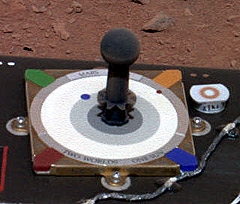
There's been something of a flap, because the early pictures showed it as bright pink, while anyone combining raw images from filters in Photoshop got blue. Don't laugh, because Photoshop's channels do a perfectly adequate job if you know what you're doing.
Now, elementary school science class tells us that blue is a shorter wavelength and scatters more, and that's why the sky is blue. Presumably, the same laws of physics apply on Mars, meaning the sky should be blue.
But the sky turns bright red every year around here, when we have our fires. There are also the many interesting shades of purple caused by L.A.'s quickly returning smog. (Thank you, SUV makers.) The NASA line about dust causing a pink sky is credible. The Martian atmosphere, such that it is, was very dusty around the time of landing.
I went to the data. That's what one does. Thought it would be a fun exercise to combine some raw Pancam images taken through the appropriate filters (L4-6).
Now, I've been reading up on this stuff, and it turns out that the data is not very good. We're not seeing the REAL raw ones and zeroes hot off the downlink. We're seeing JPGs of the result, and there's some stuff missing. Presumably the data available to users of NASA's higher-end graphics program contains more of this good stuff, because I've noticed how that program displays all sorts of information from file headers that are being stripped before we ever get them on the Mars Rover site. (More on this program later.)
Even so, I forged ahead. Here's my composite of the calibration target, from the same general period in which the Pancam made images of the sky:

No changes whatsoever from the raw images. Just dropped them into the apropriate channels. It hit the calibration target right on. On Mars, the greyscale went a bit blue, just as it would with a blue sky, but the two mirrors which reflect the sky went pinkish. Both of these are known results of using narrowband filters. In the lower right corner, we see a tiny bit of a blue wire, which has often turned pink in Pancam images. It's blue. This is a high-confidence image.
So let's look at the sky. This one was evidently photographed right after a Martian sunset. The major variables from the calibration image are brightness (big change), contrast (even bigger change), and time of day (less of a factor). We'll leave out hypothetical variables, such as the theory that NASA is changing the raw images to conceal evidence that Mars has lakes, flowers, pyramids, US military bases, and Starbucks franchises. Time, of course, is encoded in NASA's gobbledygook filenames, as seconds since 11:58:55.816 on 1/1/2000 UTC (don't ask... I just work here).
And so, we press on, taking the same filters and droping the images in, no funny stuff:

Ick.
That's the scientific conclusion of this whole exercise, which anyone can reproduce with the same images.
Ick.
Through the color-imbalanced crud, it would at first appear that Mars has a blue sky. In fact, this is now what NASA is saying too. The sky is blue. It was blue when Viking looked, it was blue when Pathfinder looked, and it's blue now. Since it's Mars, though, and not the Caribbean, it's bluest in a sort of annular area around the sun and out from it, and pinkest down near the horizon where the dust is.
In this image, however, Mars has a cyan sky with a magenta hot spot away from the sun. I've seen this, though less yukky, in all their pictures of the sky. The reason, I am told, is due to hard-limiting in the CCD cameras used by Pancam. The sequential filtered images are normalized, like putting a film camera on full-frame auto. There'll always be some black and white in the image, but the middle goes wherever it goes.
Pancam's red (601 nm) is kind of weird. This is kind of a "feature" of digital cameras in general. For various reasons, quite a bit of the data is taken with an IR filter instead of the red, and the filenames will tell you this.
At any rate, my second mix is not a high-confidence image. I could fix what looks like bad channel blending easily enough, but what would I fix it to? This is another planet.
We'll have to leave the answer to the science types, who use calibrated software on very heavy duty boxes, and take their time measuring everything because that's what scientists do. We're lucky to have any data at all.
It's not a total loss. Those whose microcomputers are on steroids (recommended 1.5 GHz processor, 1Gb RAM!) can get further into it with NASA's Maestro program. Since I'm not pretending to do science, I'll plod along with my meager 256 Mb RAM and Photoshop.
A real good technical explanation of all this, which does the same exercise and also gets an icky poo sky, is right here.
Keep watching the sky.
# # #